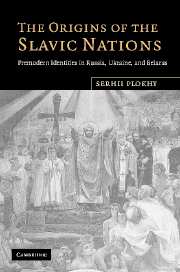Book contents
- Frontmatter
- Contents
- Preface
- Note on transliteration, dates, and translations
- Maps
- Introduction
- 1 The origins of Rus′
- 2 What happened to the Rus′ Land?
- 3 The Lithuanian solution
- 4 The rise of Muscovy
- 5 The making of the Ruthenian nation
- 6 Was there a reunification?
- 7 The invention of Russia
- 8 Ruthenia, Little Russia, Ukraine
- Conclusions
- Author index
- General index
8 - Ruthenia, Little Russia, Ukraine
Published online by Cambridge University Press: 25 July 2009
- Frontmatter
- Contents
- Preface
- Note on transliteration, dates, and translations
- Maps
- Introduction
- 1 The origins of Rus′
- 2 What happened to the Rus′ Land?
- 3 The Lithuanian solution
- 4 The rise of Muscovy
- 5 The making of the Ruthenian nation
- 6 Was there a reunification?
- 7 The invention of Russia
- 8 Ruthenia, Little Russia, Ukraine
- Conclusions
- Author index
- General index
Summary
The outcome of the Khmelnytsky Uprising forever changed the fate and identity of the land called Ruthenia and its inhabitants, the Ruthenians. The Cossack state, which came into existence in the first months of the Khmelnytsky Uprising and received international recognition during the Zboriv negotiations in the summer of 1649, became known in historiography as the Hetmanate, a term based on its later, eighteenth-century name, which is used throughout this book. But for most of the seventeenth century and the first decades of the eighteenth it was known primarily as the Zaporozhian Host, a term derived from the official name of the Cossack army, which was initially based at the Zaporozhian Sich and later in the settled area as well. It is the Zaporozhian Host that figures as an official entity in the treaties concluded by the Cossack hetmans with Muscovy, the Ottoman Empire, and the Polish-Lithuanian Commonwealth in the second half of the seventeenth century. It became the legal name of the Ukrainian state and territory, which also acquired other names related to a variety of social and national projects that were under way in the Cossack polity during the seventeenth and eighteenth centuries. One of those names was Ukraïna (Ukraine), which was preferred by middle-rank Cossack officers and, apparently, by the Cossack masses in general. Another was Rosiia, used in the literary works of the Kyivan clergy.
- Type
- Chapter
- Information
- The Origins of the Slavic NationsPremodern Identities in Russia, Ukraine, and Belarus, pp. 299 - 353Publisher: Cambridge University PressPrint publication year: 2006



